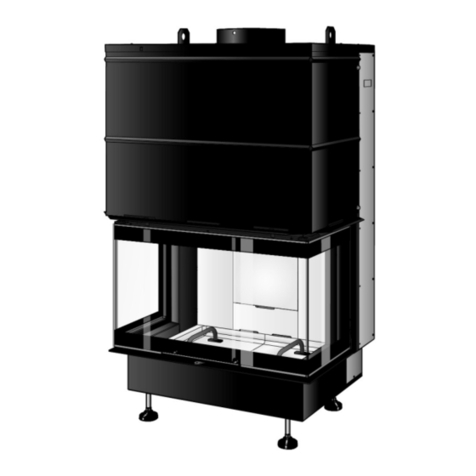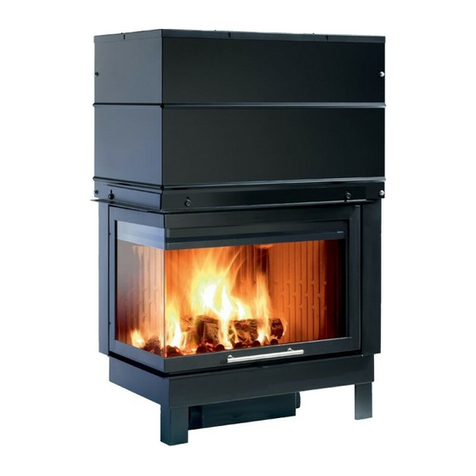LIGHT series
ENGLISH
1.4 Firewood
The following paragraphs provide technical and practical
information regarding the fuel used, so that the user will
understand the importance that Caminetti Montegrappa gives
to the selection and preparation of the fuel, and the correct
use of the appliance, which will have a signicant impact on
proper functioning as well as minimizing fuel consumption and
pollution.
Wood is the only source of energy that is:
r enewable, coming from trees and plants, whicht
grow under the action of sun light,
t organic, being produced by living organisms,
t neutral as regards carbon dioxide released into
the atmosphere (“neutral CO2”), since the CO2
produced after the combustion is that absorbed during
photosynthesis,
t clean since burning wood eciently and completely
produces only natural substances that are abundantly
present everywhere in our environment in non-toxic
concentrations for the living organisms.
1.4.1 $IBSBDUFSJTUJDTPGöSFXPPE
Firewood is usually classied into softwood (poor or fair
quality) and hardwood (good quality) depending upon its
specic weight; hardwood, which weighs more than softwood,
allows to reduce the amount of wood needed.
4PGUXPPE weighs about 300-350 kg/cu.m (with 15/20%
moisture content):
it is easy to ignite, it burns rapidly and provides a lively re.
Softwood includes the following species: r, ailanthus, locust,
chestnut, cypress, cornelian cherry, mulberry, larch, alder,
pine, poplar, willow, elder and lime.
4PGUXPPEQSPEVDFTNPSFDSFPTPUFXJUIDPOTFRVFOUJBM
OFFEGPSNPSFGSFRVFOUDMFBOJOHPGZPVSDIJNOFZøVF
)BSEXPPE weighs about 350-400 kg/cu.m (with 15/20%
moisture content):
it has a higher density and is less resinous than softwood,
it burns slowly and keeps a low ame (suitable for home
heating). Hardwood includes the following species: maple,
white birch, hornbeam, bitter oak, cherry, beech, ash, holm-
oak, walnut, olive, elm, pear, plane, oak and false acacia (those
highlighted are among the best wood types).
As seen above, rewood for heating has dierent features
according to the tree species it comes from.There are dierent
types of wood and their properties in terms of heat value
vary from species to species. The heating value of wood fuel
(kcal/kg) is the quantity of heat produced after the complete
combustion of 1 kg of wood.
The heating value of the dierent wood types is not only
aected by the density, but also by their moisture content; as
a consequence the output and the eciency of the appliance
is strictly dependent upon the type of wood burned (normally
the heating value of a well seasoned wood is 3200 kcal/kg).
Here nd some comparative data:
SOFTWOOD = kcal/kg 2800 - 3400t
HARDWOOD = kcal/kg 3400 - 3900t
WOOD BRIQUETTES = kcal/kg 3850 - 4200t
WOOD PELLET = kcal/kg 4200 - 4600t
5IFPOMZGVFMBENJUUFEGPSUIFBQQMJBODFVTFJTöSFXPPE
BOEJUTCZQSPEVDUT
5IF VTF PG BOZ PUIFS UZQF PG TPMJE GVFM FH DPBM JT
'03#*%%&/
'JSFXPPEJT
timber at a natural state, in pieces or not (logs, ort
briquettes free of any binders or additives, kindling, shavings
from processing trees), deadwood like branches and pine
cones;
wood residues created by the furniture manufacturing ort
the construction industry, provided they are not painted or
treated.
'JSFXPPEJTOPU
any wood scrap coming from house demolition, restorationt
or renovation, or coming from packing material (pallets),
wooden furniture, Formica, even if mixed with natural wood;
any other wood material such as painted, varnished andt
treated wood scraps even if mixed with natural rewood.
*G QPTTJCMF BWPJE UIF VTF PG SFTJOPVT XPPE BT JU DBO
QSPEVDFPCTUSVDUJPOTXIJDIEBNBHFUIFJOOFSQBSUT
PGUIFBQQMJBODFöSFCPYBOEUIFDIJNOFZøVF
1.4.2 1SFQBSJOHöSFXPPE
Therewoodmanufacturingprocessesvarygreatlydepending
upon the nal type of fuel to produce: wood pieces, briquettes
or pellets.
Wood pellets or briquettes are produced only in big sawmills
that have large quantities of shavings and sawdust at disposal,
which become valuable products for an appealing market.
Individuals who are landowners can easily obtain the amount
of wood that will be needed for their home heating.
Those who are not landowners can address dealers
experienced in rewood combustion, who can advise about
quality and wood species locally available.
The most important steps in producing rewood are the
following:
cutting of trees or suckers (usually on waning moon or int
winter);
trimming of the smaller branches from the trunk (usuallyt
when they are less than 4 cm in diameter);
tcutting of trunks and branches into 1 m long logs;
cutting of the bigger logs in half along their lengtht
(quartering);
tpiling of the sawn logs in a dry, ventilated location favouring
We highly reccomend not using softwoods!































